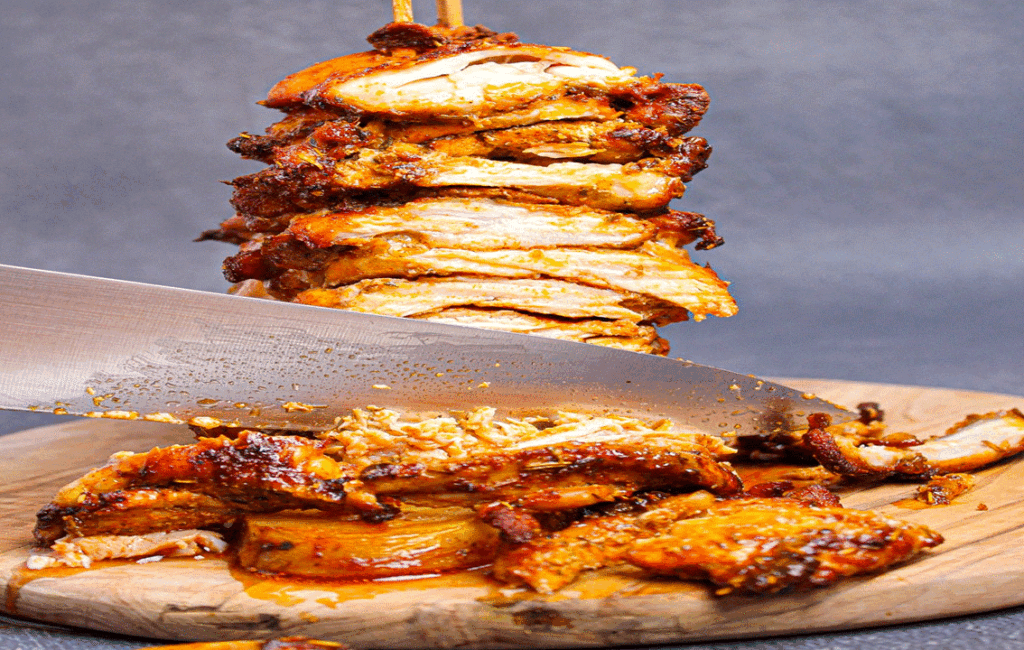A DELICIOUS WRAP
THE HUMBLE GYRO
Several culinary experts see the humble gyro as a testament to the rich culinary history of the Greek people. Indeed, this perfect parcel of roasted meat has gone on to become a culinary icon of both Greece and Cyprus. Although most people simply see it as just a delicious wrap, to others, it represents something much more. The gyro as a result, helps to form a delectable meal that has sprouted from the roots of the Mediterranean diet.
A FUSION OF FLAVOURS
A FUSION OF FLAVOURS
The gyro remains relevant as new adaptations of it continue to emerge in contemporary kitchens worldwide. The fusion of the flavours and their traditions remains a good representation of Hellenism, and because of this, the simple, yet elegant fast food has remained synonymous with both Greek and Cypriot cuisines.
A BLEND OF SPICES, OLIVE OIL & VINEGAR
MARINATED FOR SEVERAL HOURS
Essentially a fast food, the traditional gyro consists of different meat products. These include pork, chicken, lamb, and beef. The meat is usually marinated for several hours. This infuses the flavour and creates a unique fresh taste. The most common Greek marinade usually uses a blend of different spices, olive oil, and vinegar. The Turkish döner, which primarily uses beef, uses different marinades, as does the Lebanese Shawarma, which typically uses chicken.
VERTICALLY ROASTED
THE GREEK WORD FOR TURNING
The term gyro derives from the Greek word for ‘turning’. This directly refers to the method used for roasting the meat. A large rotisserie skewer is prepared by layering sections of marinated meat. This is then slowly vertically roasted while constantly turning.
A CRISPY OUTER LAYER
PERFECTLY COOKED SUCCULENT MEATS
The differing degrees of heat culminate in perfectly cooked, succulent pieces of meat. Once the meat forms a crispy outer layer, it is shaved off for serving. The shavings are then combined with fresh tomatoes, onions, and sometimes fries, along with a generous drizzle of rich creamy tzatziki sauce. All of these simple ingredients are then tightly packed into a specific type of circular flat pita bread that resembles a wrap.
A FRESH HOMEMADE SAUCE
ENHANCING THE OVERALL GYRO EXPERIENCE
The tzatziki sauce is usually homemade. It typically contains fresh cucumber, garlic, and dill. This sauce is usually served cold over the meat. This offsets the often-vibrant spices. This often adds a refreshing contrast that enhances the overall gyro experience.
CONTEMPORARY COOKING METHODS
ROASTING MEAT ON OPEN CAMPFIRES
Contemporary methods of this type of cooking have existed throughout the ages. The roots of roasting marinated meat over open fires, as we know it today, trace back to ancient Greece. Historical documents suggest that ancient Greeks were practising cooking over open fires in an organised manner, as far back as the 5th century BC. Greek soldiers, mainly during campaigns of war, would butcher their allocated animal and then place sections of their meat onto their swords. They would then roast their meat on open campfires. Whilst this is mainly accepted for the conventional horizontal form of kebab preparation, the story of the vertical rotisserie is quite different.
A RAPID DEVELOPMENT
A CRUDE VERSION OF VERTICLE ROASTING
The Ottomans are thought to have been the first to introduce the vertical rotisserie. This is supported by the fact that Greek migrants, particularly from the Izmir region of modern-day Turkey, are thought to have introduced a crude version of this cooking method to Greece after they arrived as refugees. The vertical rotisserie continued to evolve throughout the late part of the 19th century and the early part of the 20th century. It reached its current form by the mid-20th century. This allowed it to establish this form of cooking as the main staple of the fast-food industry throughout Greece.
CULTURAL EXCHANGES BETWEEN GREECE & CYPRUS
A STAPLE OF CYPRIOT CUISINE
The gyro was also introduced to Cyprus by Greek migrants. While the exact individual or event that brought it to Cyprus is not documented, it is widely accepted that it became popular during the mid-20th century. It has since become a staple in Cypriot cuisine, enjoyed for its delicious flavours and ease of preparation.
SPREAD ALL OVER THE WORLD
AN AMERICAN DREAM
OTHER VARIATIONS
CONNECTING PEOPLE FROM ALL OVER THE WORLD
Whilst the gyro’s significance in today’s food courts continues to be recognised as an embodiment of Greek flavours, other good examples of other variations of it are the Turkish döner kebab and the Middle Eastern shawarma kebab. These both resemble the gyro, and they share not only in its concept, but also in its origin.
THE SPIRIT OF GREEK CULINARY CULTURE
A SIGNIFICANT FOOD IN TODAY’S FOOD COURTS
The gyro today represents the spirit of Greek culinary culture. In most ways, it also serves as a good example of modern Greek culinary innovation and in other ways it just simply provides a wholesome fast food. Its popularity remains enduring, and as it continues to be adopted by various cultures, it remains a staple in global fast food culture. The gyro’s significance in today’s food courts continues to be recognised as an embodiment of Greek flavours.
CONNECTING PEOPLE FROM ALL OVER THE WORLD
A VERSATILE MODERN-DAY STATUS
From its ancient origins to its modern-day status, this versatile fast food continues to stand as a representation of the Greek people. Enchanting taste buds from all around the globe, it is fair to say that this food holds the power to connect people from all over the world. Ultimately, whether a gyro is enjoyed at a humble food stall in Athens or a trendy eatery in New York, it remains a delicious reminder that Greek food in all of its forms.


A CULTURAL
& CULINARY MEDITERRANEAN ICON





